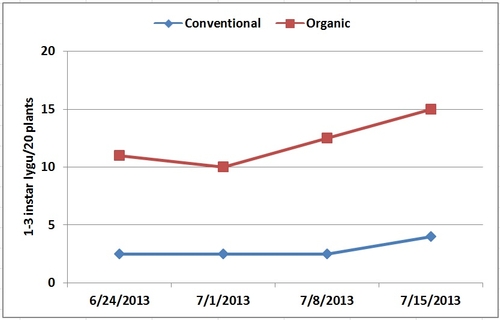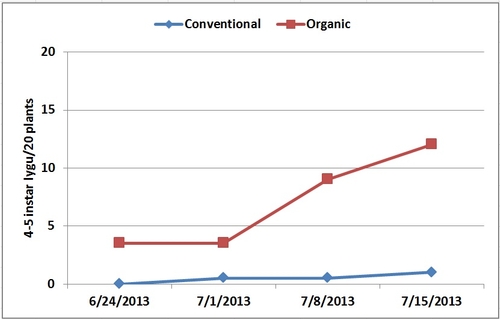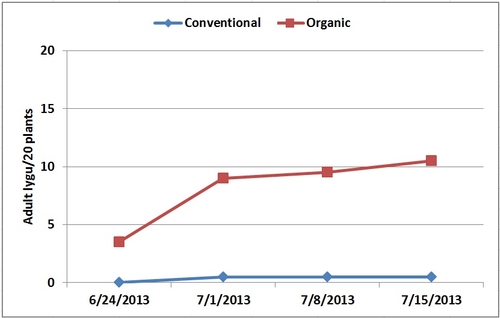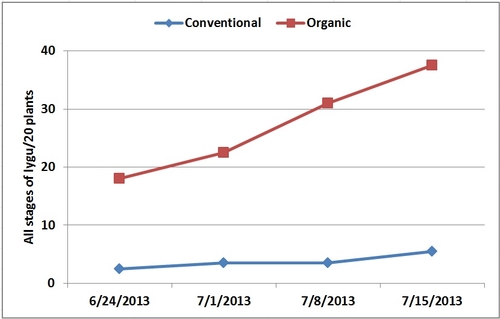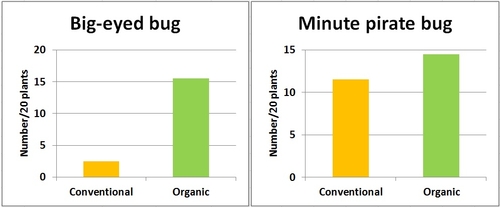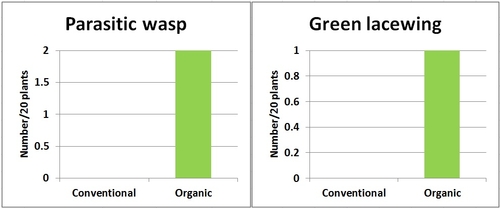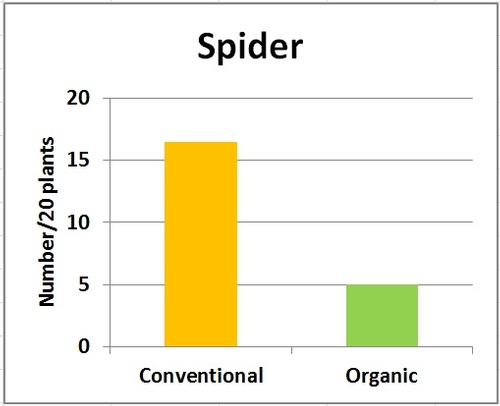Integrated pest management recommends using multiple approaches such as selection of resistant varieties, manipulation of habitat and modifying cultural practices in a manner that is not beneficial to the pest, and conserving natural enemies before using pesticides. In certain production systems that have well established agronomic practices with limited scope for modifying the habitat or cultural practices, pest management is primarily dependent on pesticide applications. There are several options for conventional strawberry production where pesticides from different classes (based on their mode of action) can be used against one or more pests. However, these options are limited in organic strawberries. As a result, some growers put a major emphasis on conserving natural enemies and timing the application of organic oils, pyrethrins, and other products in a manner that is least disruptive to natural enemies.
In a 2009 study, seasonal average for lygus bug (Lygus hesperus) numbers did not show a specific trend between organic and conventional strawberry fields. The average number of nymphal and adult stages of lygus bugs, from mid-May to the end of August, was 12.6 from 20 plants in an organic field. This average was 15.6 (between mid-May and mid-July) in a conventional field and 7.7 (between mid-May and mid-August) in another conventional field. Conventional fields received several pesticide applications while the organic field received only two during the study suggesting that pesticide applications did not really help to bring lygus populations below threshold levels (1 lygus bug nymph per 20 plants). As the natural enemy populations were not monitored during this study, the impact of pesticide applications on their numbers or their role in managing lygus populations was not clear.
To understand the lygus bug and their natural enemy interactions more, another study was conducted in 2013 on a commercial organic and a conventional strawberry field in Santa Maria. Observations were made at weekly intervals from June 24 to July 15 where 10 randomly selected plants from each of the four quadrants of an acre area were sampled using a beating tray. The number of young (1st-3rd instar) and mature nymphs (4th to 5th instar) and adults of lygus along with their natural enemies – big-eyed bugs (Geocoris spp.), minute pirate bugs (Orius spp.), green lacewings (unknown), damsel bugs (Nabis spp.), parasitic wasps (unknown), lady beetles (multiple species), and spiders (multiple species) was recorded.
Among various materials that were applied in the conventional field, abamectin (Epi-Mek 0.15 EC applied once), sodium tetraborohydrate decahydrate (Prev-Am, applied thrice), and sulfur (Microthiol Dispress applied once) were primarily used as acaricides. Novaluron (Rimon 0.83EC) was applied on May 22, about one month prior to the first sampling. Aadjuvant, pinene (polyterpenes) polymers (Miller Nu Film P) was also applied thrice between May 7 and June 22. In the organic field, neem oil (Trilogy) and alcohol ethoxylate (OROBOOST) were each applied thrice between May 1 and July 11.
A higher number of lygus bugs were seen in the organic field than in the conventional field throughout the observation period. While the older nymphs and adults stayed at or below the treatment threshold, younger nymphs were consistently above the threshold (2.5 to 4 per 20 plants) in the conventional field. In the organic field, they were consistently above the treatment thresholds during the observation period.
Occurrence of lygus bug nymphs and adults in a conventional and an organic strawberry field in Santa Maria from Jue 24 to July 15, 2013.
When the average number of natural enemies for the observation period was considered, the organic field had more big-eyed bugs than the conventional field. The organic field also had slightly higher numbers of minute pirate bug and lady beetles. Very low numbers of lacewings or parasitic wasps were present only in the organic field. In general, damsel bug numbers were also very low, but they were slightly higher in the conventional field. A higher number of spiders were seen in the conventional field compared to the organic field.
Although some key species of natural enemies were present at higher numbers in the organic field, they were not able to keep the lygus populations under control. On average, there were 10 natural enemies of all species per 20 plants in the conventional field and 12 in the organic field during the observation period. Applying novaluron at the right time appeared to control lygus bug nymphs and prevented population build up there after in the conventional field. While natural enemies generally play a significant role, this study suggests the importance of other options such as pesticides for managing lygus bugs.
http://ucanr.edu/articlefeedback
Acknowledgements: Thanks to Dave Peck (Manzanita Berry Farms and Eraud Farms, Santa Maria) for his collaboration and Chris Martinez for technical assistance.
